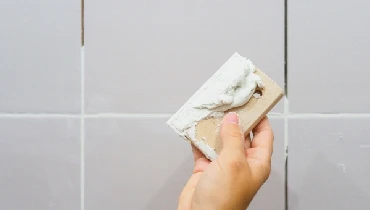Grout vs. Caulk: An Overview

In kitchens and bathrooms across the globe, you’ll find tiles and fixtures, such as toilets, pedestal sinks, and tubs, caulked and grouted. But what exactly is caulk? Or grout, for that matter?
In this article, we’ll review each one, discuss the differences between caulk and grout, and explain how and when each should be used.
Composition and Properties of Grout vs. Caulk
Grout
At its core, grout is a powder of cement or epoxy and sand that needs water to activate its adhesive properties. Once the water evaporates out of the mixture, grout sets to a rock-hard consistency.
There are several different types of grouts (depending on additives). Each one offers advantages based on how and where it is used. Here is a brief description of each:
- Unsanded Grout: This is usually twice as expensive as sanded grout and is available in either cement or epoxy base. Dries with a smooth finish that is best used on tile, such as limestone or marble, that might be scratched by sanded grout. Unsanded grout can shrink and crack when exposed to pressure. It is not recommended for areas with heavy foot traffic.
- Fine Sanded Grout: Less expensive, coarse texture grout. Available in either cement or epoxy base, and does not shrink or crack. It holds up well in areas that have heavy foot traffic.
- Epoxy: A mixture of resin, hardener, and sand. Usually, epoxy grouts are used in areas exposed to harsh chemicals, heat, moisture, vibration, repeated heavy loads, and other operational and environmental stresses because it has shown excellent resistance to damage in these situations.
Caulk
Unlike grout, caulk is a latex-, silicone-, or acrylic-based product that, even after setting, maintains some flexibility, which is great for areas that need to accommodate movement and expansion, such as a bathroom or other moisture-dense places.
Differences in Application
One of the biggest differences between grout vs. caulk is how and where they are applied. Grout is primarily used in masonry applications within the home but is most commonly used in tiling jobs. Since it is supplied in powder form, it will need to be mixed by the installer to achieve the thick, smooth consistency needed for the application.
On the other hand, caulk comes already prepared. Caulk is a versatile and useful material for sealing cracks and seams in a shower and tub, around a bathroom and/or kitchen sink, and around windows and doors.
Aesthetic Considerations
As with any other home maintenance material, aesthetics are also part of the caulk vs. grout consideration. Both materials are available in a wide range of colors, allowing you to match different surfaces. If you can’t find the color you want, you can also stain caulk to fit your needs.
If you are looking for a material that blends into the surrounding surface, caulk might be the best option. Since it is applied in thin lines, it is much less visible to the naked eye. Grout is applied in larger sections, so it plays a bigger role in the appearance of your project.
Durability and Maintenance
When it comes to durability, grout is generally more durable than caulk. However, caulk is usually a better choice in areas where moisture will accumulate, thanks to its flexibility.
Caulk is also much easier to clean. While it is porous, it doesn’t absorb dirt as much as grout does. Since it is not moisture resistant, grout tends to hold moisture and dirt, causing it to become discolored over time.
The Grouting Process
The grouting process takes a bit longer due to the need to make the mixture. After you select the type of grout you want to use, apply a thick layer of it over the tiles. Work at a 45-degree angle to make sure that the grout gets into all of the open areas. After about 15 minutes, wipe away any excess grout and clean up the area. Wait until 24 hours for the grout to cure completely.
The Caulking Process
Since caulk comes ready to use, the process begins more quickly than the grouting process does. Once you purchase your caulk tube, cut a hole the same width as the joint you’ll be sealing in the top at a 45-degree angle. Place the tube in a caulk gun and use it to apply a smooth layer of caulk to fill the necessary joints. After the caulk has been applied, use a smoothing tool to smooth out your line. This will help to ensure that the caulk gets into every area of the joint so you can achieve a water-tight seal.
Troubleshooting and Tips
Typically, you should use caulk in bathrooms due to its flexible, waterproof, and non-porous composition. Caulk is also easier to remove and replace when necessary, which will minimize damage to your fixtures.
Keep in mind that sometimes a project will require both grout and caulking. Once the grout has set and hardened, use caulk to provide a waterproof seal.
Remember to properly clean your surface before and after you apply caulk or grout. If the area is not probably cleaned beforehand, you could have issues achieving the appropriate seal. If it is not cleaned up properly after completing your project, it will look messy and unfinished.
If your project is not properly maintained and cleaned, you also risk problems with mold or mildew. If this becomes an issue, you may have to remove the caulk and start the project over again.
When to DIY and When to Call a Professional
So, how will you know when you can DIY a grout vs. caulk project and when it would be better to find a local handyman near you? This answer comes down to your skill level and comfortability with home projects. For those with the time, tools, and skill, grouting or caulking can be a DIY project.
For most people, though, it’s best to call in the professionals. The professionals at Mr. HandymanⓇ have performed caulking and grouting projects as part of our handyman services for years. All of our projects come backed by the Neighborly Done Right Promise™, so you can rest assured that your job will be done right.
If the idea of deciding between grout vs. caulk is making your head spin, the experts at Mr. Handyman would be more than happy to help. Request service today!
 Click to call
Click to call


